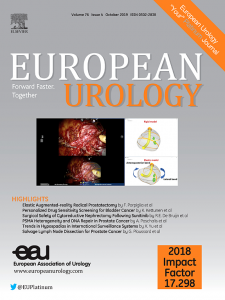The Role of Prostate-specific Membrane Antigen Positron Emission Tomography for Assessment of Local Recurrence and Distant Metastases in Patients with Biochemical Recurrence of Prostate Cancer After Definitive Treatment: A Systematic Review and Meta-analysis
IF 25.3
1区 医学
Q1 UROLOGY & NEPHROLOGY
引用次数: 0
Abstract
Background and objective
Positron emission tomography (PET) with prostate-specific membrane antigen (PSMA) radioligands has an established role in the assessment of recurrence of prostate cancer (PC) after primary treatment. However, an updated understanding of its diagnostic utility is warranted, particularly in the context of emerging targeted and systemic treatment options for recurrent PC. Our aim was to evaluate the diagnostic performance of PSMA PET for staging and detection of local or metastatic disease in patients with biochemical recurrence (BCR) following definitive treatment for PC.Methods
We conducted a systematic review (Web of Science/MEDLINE, Cochrane Library, and EMBASE from inception to April 25, 2024) and meta-analysis. Eligible retrospective and prospective studies had extractable data on PSMA PET for patients with BCR after radical prostatectomy (RP) or radiation therapy (RT). Risk of bias was assessed using the QUADAS-2 tool. Random-effects models were used to evaluate PSMA PET positivity rates across clinical subgroups stratified by PSA, primary treatment, PSMA PET radioligand, and anatomic lesion sites.Key findings and limitations
A total of 43 studies (8119 patients) were included. PSMA PET positivity rates varied substantially among patients with BCR after primary definitive treatment, with significant study heterogeneity (τ2 = 0.6; p < 0.001), which was mitigated in part after stratification by PSA category. Positivity rates were significantly higher after RT (92%) than after RP (60%; p < 0.001). PSMA PET positivity by anatomic location was 23% for local recurrence, 32% for pelvic nodes, 14% for extrapelvic nodes, 16% for bone metastases, and just 1% for visceral metastases. The positivity rate increased with PSA, from 48% at PSA 0.2–0.5 ng/ml to >90% at PSA >2 ng/ml. Gleason score (GS) at RP did not significantly influence the positivity rate (50% for GS ≤7 vs 62% for GS 8–10; p = 0.08). Heterogeneity limits the generalisability of our findings.Conclusions and clinical implications
We observed substantial variability in PSMA PET positivity rates in BCR because of significant study heterogeneity, mostly related to differences in treatment type, PSA, and anatomic sites. In post-RP BCR, approximately half of patients undergoing PSMA PET had positive findings, even at low PSA (0.2–0.5 ng/ml). In the post-RT setting, PSMA PET use was generally aligned with the Phoenix criterion for BCR, with most studies performing PSMA PET at PSA ≥2 ng/ml. Further research is needed to refine PSA thresholds for PSMA PET, particularly in the post-RT setting, and to assess its role in guiding salvage treatment decisions.前列腺特异性膜抗原正电子发射断层扫描在前列腺癌最终治疗后生化复发患者中评估局部复发和远处转移的作用:一项系统综述和荟萃分析
背景与目的前列腺特异性膜抗原(PSMA)放射配体正电子发射断层扫描(PET)在原发性治疗后前列腺癌(PC)复发评估中的作用已经确立。然而,对其诊断效用的最新理解是有必要的,特别是在复发性PC出现靶向和系统治疗选择的背景下。我们的目的是评估PSMA PET对PC最终治疗后生化复发(BCR)患者的局部或转移性疾病的分期和检测的诊断性能。方法采用系统评价(Web of Science/MEDLINE, Cochrane Library, EMBASE)和meta分析(从成立到2024年4月25日)。符合条件的回顾性和前瞻性研究获得了根治性前列腺切除术(RP)或放射治疗(RT)后BCR患者PSMA PET的可提取数据。使用QUADAS-2工具评估偏倚风险。随机效应模型用于评估按PSA、初始治疗、PSMA PET放射配位和解剖病变部位分层的临床亚组的PSMA PET阳性率。主要发现和局限性共纳入43项研究(8119例患者)。初步确定治疗后BCR患者的PSMA PET阳性率差异显著,具有显著的研究异质性(τ2 = 0.6;p & lt;0.001),在按PSA类别分层后,这一现象得到了部分缓解。RT后的阳性率(92%)明显高于RP后的阳性率(60%;p & lt;0.001)。局部复发的PSMA PET阳性为23%,盆腔淋巴结为32%,盆腔外淋巴结为14%,骨转移为16%,内脏转移仅为1%。阳性率随PSA升高而升高,从PSA 0.2 ~ 0.5 ng/ml时的48%上升到PSA 2 ng/ml时的90%。RP的Gleason评分(GS)对阳性率无显著影响(GS≤7为50%,GS 8-10为62%;p = 0.08)。异质性限制了我们研究结果的普遍性。结论和临床意义由于研究的异质性,我们观察到BCR中PSMA PET阳性率的显著差异,主要与治疗类型、PSA和解剖部位的差异有关。在rp后BCR中,大约一半接受PSMA PET的患者即使在低PSA (0.2-0.5 ng/ml)下也有阳性结果。在放疗后的环境中,PSMA PET的使用通常符合凤凰标准的BCR,大多数研究在PSA≥2 ng/ml时进行PSMA PET。需要进一步的研究来完善PSMA PET的PSA阈值,特别是在rt后的环境中,并评估其在指导救助治疗决策中的作用。
本文章由计算机程序翻译,如有差异,请以英文原文为准。
求助全文
约1分钟内获得全文
求助全文
来源期刊

European urology
医学-泌尿学与肾脏学
CiteScore
43.00
自引率
2.60%
发文量
1753
审稿时长
23 days
期刊介绍:
European Urology is a peer-reviewed journal that publishes original articles and reviews on a broad spectrum of urological issues. Covering topics such as oncology, impotence, infertility, pediatrics, lithiasis and endourology, the journal also highlights recent advances in techniques, instrumentation, surgery, and pediatric urology. This comprehensive approach provides readers with an in-depth guide to international developments in urology.
 求助内容:
求助内容: 应助结果提醒方式:
应助结果提醒方式:


